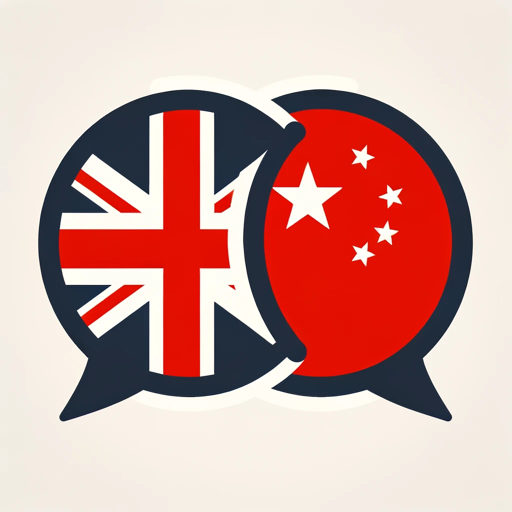Translate to Chinese-AI-Powered Chinese Translator
AI-Powered Translation to Chinese
Type or paste in any human language
Translate to proper Chinese
Related Tools
Load More
Chinese 智译
无需说明,自动在中文和其他语言间互译,支持翻译代码注释、文言文、文档文件以及图片。No need for explanations, automatically translate between Chinese and other languages, support translation of code comments, classical Chinese, document files, and images.

Chinese Translator
Bilingual English/Chinese translator with Pinyin support. Visit https://translate.mom for video translations! Created by https://x.com/montakaoh

English 翻译天团
精准翻译家:让英语老师、中文老师和校长共同帮你翻译英文文章。Credit @dotey

双语翻译器
英汉翻译工具,输中文翻英文,输英文翻中文,仅提供翻译结果

Translate GPT (Chinese to English Translation)
Translate GPT will help you translate from Chinese to English for any text.
中文翻译
中文翻译与简繁切换专家
20.0 / 5 (200 votes)
Introduction to Translate to Chinese
Translate to Chinese is a specialized version of ChatGPT designed to translate text from various languages into Chinese. It focuses on delivering accurate, contextually relevant translations while preserving the original meaning and nuances. This service is particularly adept at handling everyday conversations, business communications, and technical documents. For instance, if you need to translate a casual conversation from English to Chinese, Translate to Chinese can ensure the tone and context are maintained. Similarly, for a technical manual, it will translate complex terminologies accurately, making it useful for professional applications.

Main Functions of Translate to Chinese
Accurate Translation
Example
Translating a user manual for a software application from English to Chinese, ensuring all technical terms are correctly interpreted.
Scenario
A software company expanding to the Chinese market needs their user manuals translated to ensure their new customers can use their product effectively.
Contextual Relevance
Example
Translating marketing material from English to Chinese, preserving the original tone and persuasive elements.
Scenario
A marketing team needs to localize their campaign for the Chinese audience, maintaining the same impact and appeal as the original.
Cultural Nuance Sensitivity
Example
Translating a business email from German to Chinese, ensuring the formality and politeness levels are appropriate for the Chinese context.
Scenario
An international company communicates with their Chinese partners, requiring translations that respect cultural differences and business etiquette.
Ideal Users of Translate to Chinese
Businesses
Companies engaging in international trade or expanding into the Chinese market will benefit from accurate translations of their documents, marketing materials, and communications, ensuring they effectively connect with their Chinese-speaking audience.
Individuals
People learning Chinese or needing to communicate with Chinese speakers can use this service for translating personal correspondence, study materials, or casual conversations, ensuring clarity and cultural appropriateness.

How to Use Translate to Chinese
1
Visit aichatonline.org for a free trial without login, also no need for ChatGPT Plus.
2
Input the text you wish to translate into the designated text box. Ensure your text is clear and contextually complete for the best translation results.
3
Select the language of the original text if it is not automatically detected. Confirm that the target language is set to Chinese.
4
Click on the 'Translate' button. The system will process your request and provide the translated text in Chinese.
5
Review the translated text for accuracy. Use the provided tools to make any necessary adjustments or rephrase specific sections to better suit your needs.
Try other advanced and practical GPTs
Simulately
AI-powered robotics simulation for research.

Optimal Instructions Builder
Streamline GPT creation with AI.

Lyric Writer
AI-powered song lyric creation
3D avatar translator
AI-powered tool for 3D avatars

ProofGPT
AI-Powered Proof Writing Assistant

Transform Your Unprofessional Message
Turn casual messages into professional communication
APA7 GPT
AI-powered APA 7 formatting made easy

所見作成サポーター
Effortless Feedback with AI Power.

Human Touch Writer
AI-powered tool for human-like writing.
SailorB2B
AI-driven solutions for smarter B2B sales.

AIGPT
AI-Driven Solutions for Your Content Needs

LogiCheck
AI-powered tool for logical analysis

- Academic Writing
- Creative Writing
- Business Communication
- Technical Documents
- Casual Conversation
Detailed Q&A about Translate to Chinese
What types of text can I translate using this tool?
You can translate a wide variety of texts, including everyday conversations, business communications, technical documents, academic papers, and creative writing. The tool is designed to handle different contexts and provide accurate translations.
Do I need to have a ChatGPT Plus subscription to use Translate to Chinese?
No, you do not need a ChatGPT Plus subscription. You can visit aichatonline.org and use the translation tool for free without logging in.
How can I ensure the translated text maintains the original tone?
When entering your text, provide as much context as possible and specify the desired tone if necessary. The translation tool is designed to adapt to various tones, whether formal or informal, to maintain consistency.
What are the common use cases for Translate to Chinese?
Common use cases include translating business emails, academic research, marketing materials, user manuals, and casual conversations. The tool is versatile and can be used in both professional and personal settings.
Are there any tips for optimizing my translation experience?
Ensure your original text is clear and free of ambiguities. Provide necessary context and avoid idiomatic expressions that might not have direct equivalents in Chinese. Reviewing and making minor adjustments to the translated text can also enhance accuracy.